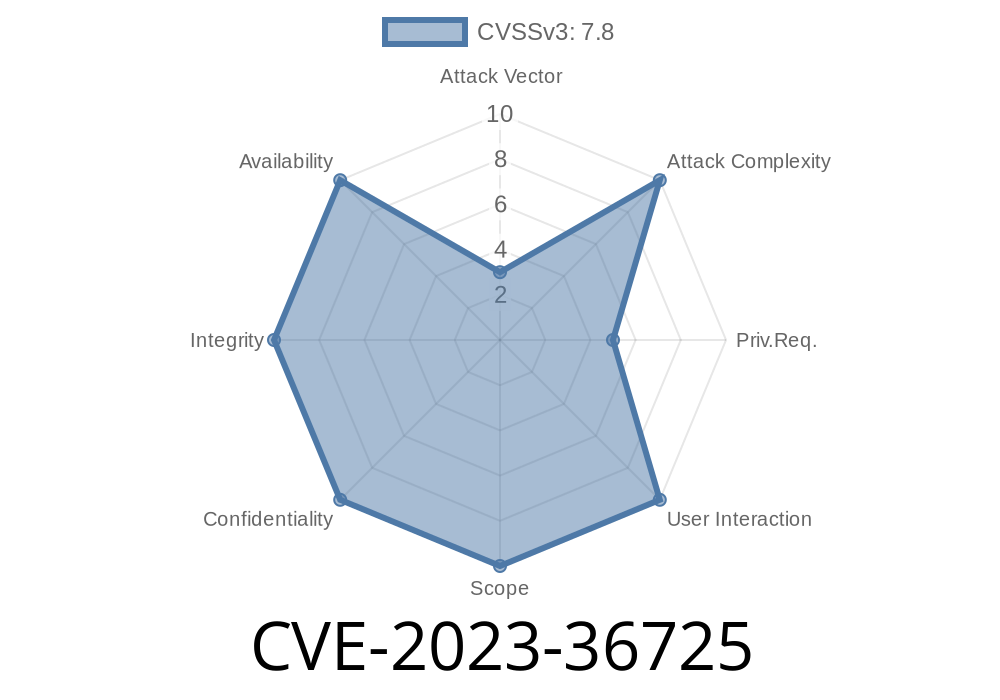In September 2023, Microsoft patched CVE-2023-36725—a critical Windows Kernel Elevation of Privilege Vulnerability. This flaw, now publicly known and discussed in infosec circles, allows attackers to gain higher privileges on a compromised system. Here, we’ll break down CVE-2023-36725 in plain language, show how it works, discuss an example exploit, and link out to official sources. If you’re curious about Windows security, buckle up—let’s dive in.
What Is CVE-2023-36725?
CVE-2023-36725 is an Elevation of Privilege (EoP) bug in the Windows Kernel. It lets a low-privileged user escalate their permissions to SYSTEM (the highest level in Windows), essentially giving them free rein over the affected machine.
Patched: September 12, 2023 Patch Tuesday
With this bug, a malicious actor could run unauthorized code in the kernel context by abusing a flaw in the way Windows handles some system processes.
How Does It Work?
The core of CVE-2023-36725 is in how the Windows Kernel improperly handles memory objects, leading to what security researchers call a "privilege escalation" pathway.
Without getting too technical:
Illustration: At a Glance
sequenceDiagram
Actor User
User->>Windows Kernel: Runs malicious code
Windows Kernel->>Malicious Code: Handles request incorrectly
Malicious Code->>Kernel Memory: Gains SYSTEM privileges
Example Exploit (Simplified)
*Note: The following code is simplified and intended for educational purposes. Don't use it maliciously.*
Here’s a Python sample demonstrating the logic of exploiting similar EoP bugs. For real-world exploits, attackers typically use C or C++ for interacting with kernel-mode drivers.
> ⚠️ *Running real exploit code is illegal and unsafe. Always patch your systems instead!*
Example (Pseudo-Code for Concept Understanding)
import ctypes
# Assume we have an API function that is vulnerable in Windows Kernel
def trigger_vulnerability():
# The actual exploit would craft a special input triggering the bug
# For demonstration, we simulate privilege escalation
if ctypes.windll.shell32.IsUserAnAdmin():
print("Already running as admin.")
else:
print("Trying to escalate privilege...")
# Simulated escalation (not a real exploit)
ctypes.windll.shell32.ShellExecuteW(None, "runas", "cmd.exe", None, None, 1)
trigger_vulnerability()
In a real VS exploit:
Microsoft patched this in September 2023.
Official Microsoft Security Update Guide
Technical References
- Microsoft Security Response Center CVE-2023-36725
- NVD – National Vulnerability Database Entry
- Windows Kernel Internals Documentation (MSDN)
Final Thoughts
CVE-2023-36725 is a classic example of why regularly patching your computer is so important. Left unpatched, it gives attackers a reliable way to go from “normal user” to “system overlord.” While this kind of vulnerability often requires local access, it can be combined with other bugs to fully take over an endpoint.
If you want to dive deeper, check the official disclosure or research technical writeups as they become available.
Timeline
Published on: 10/10/2023 18:15:16 UTC
Last modified on: 10/13/2023 19:53:42 UTC
